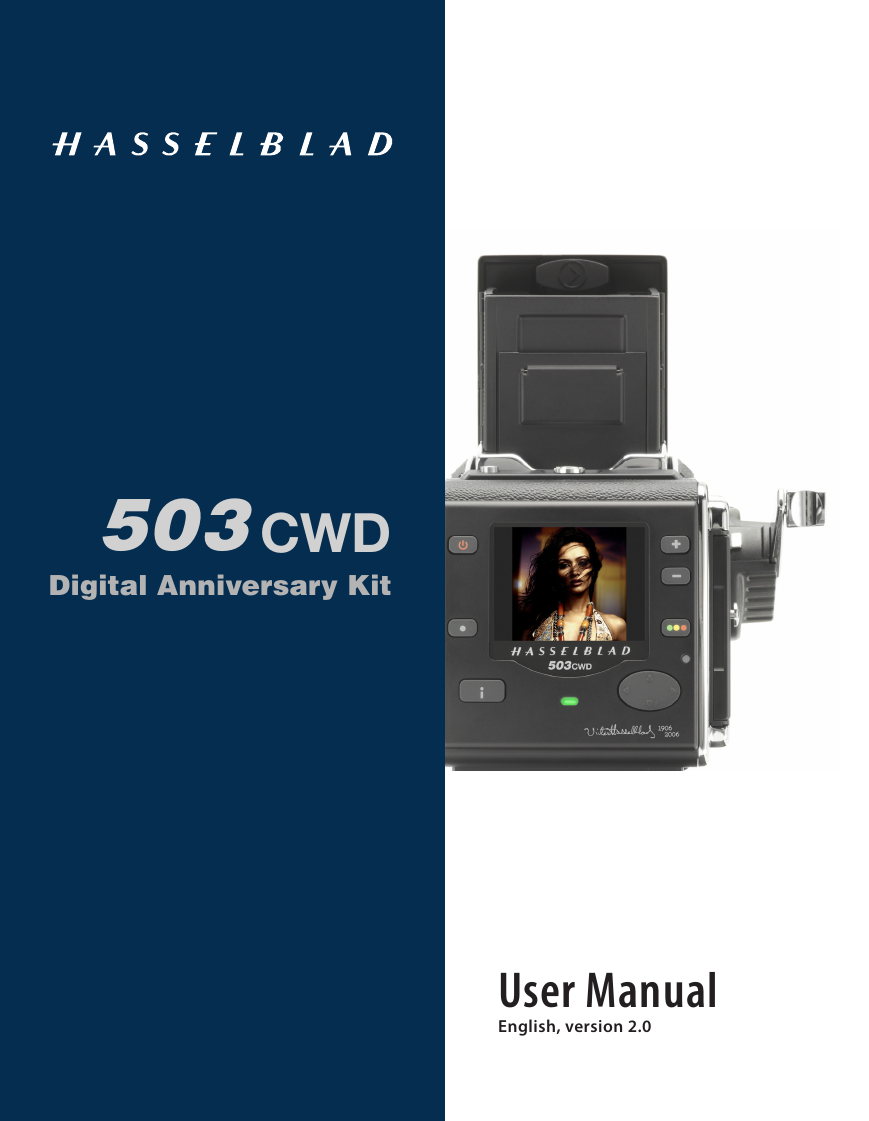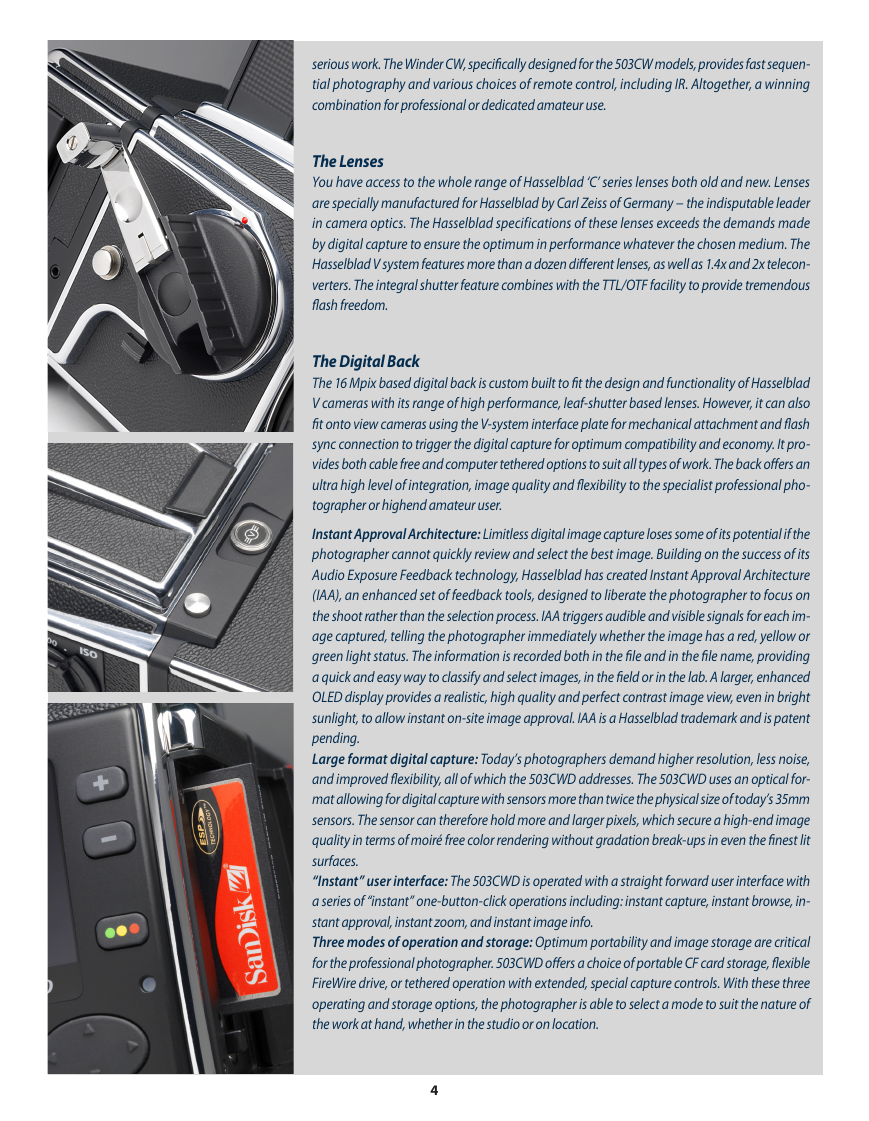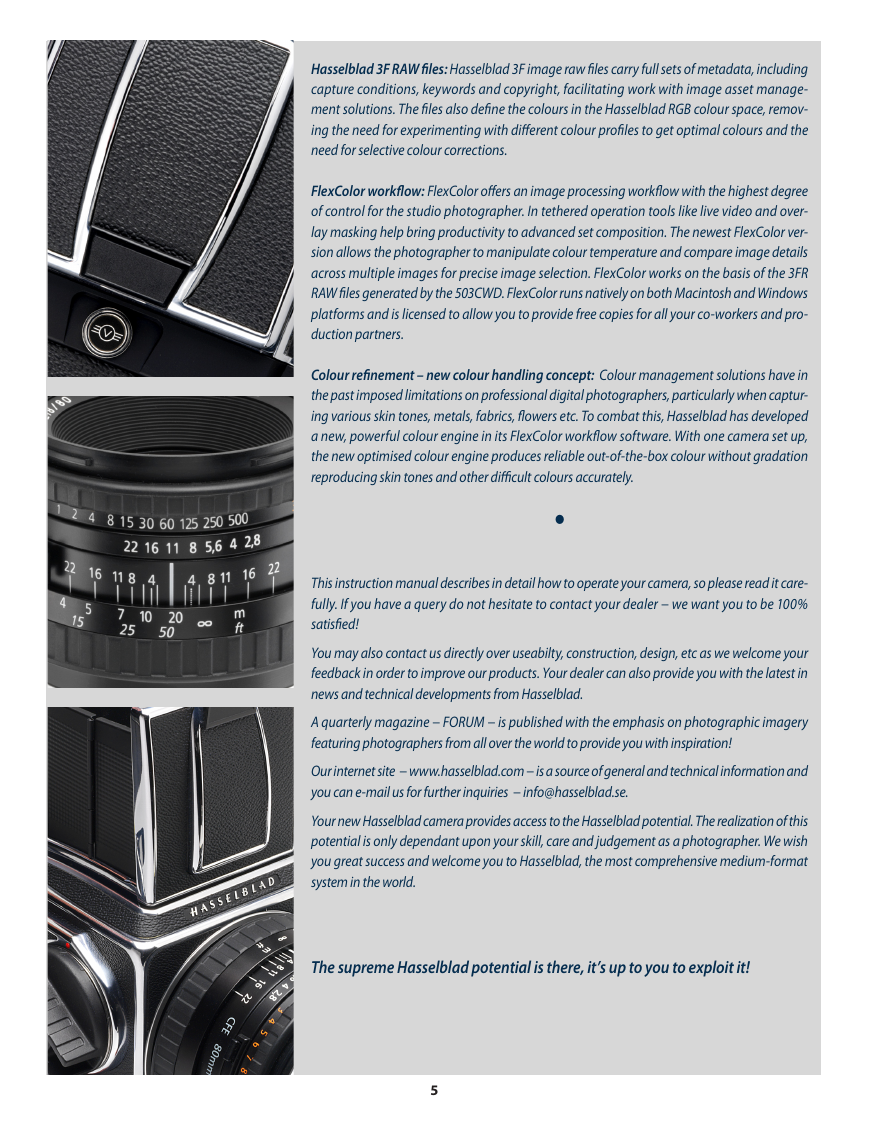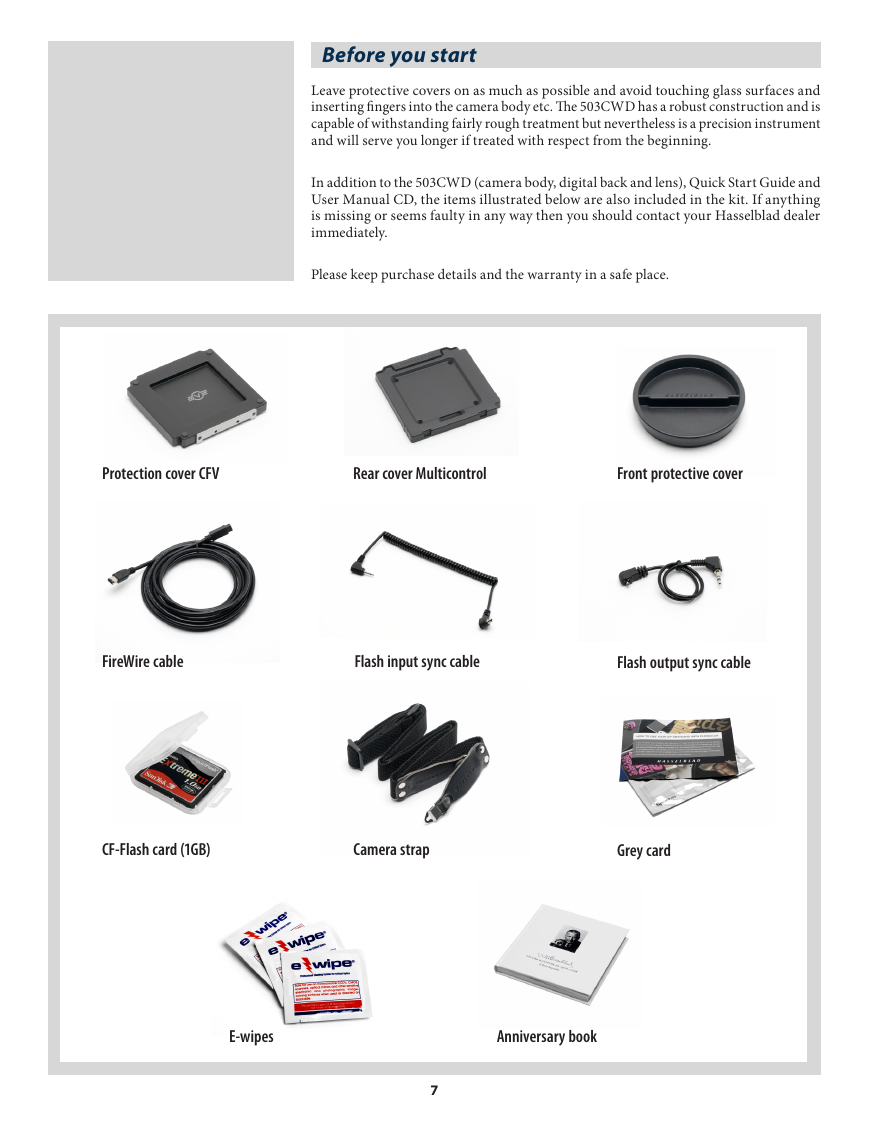501
503CWD
Digital Anniversary Kit
User Manual
English, version 2.0
�
C O N T E N T S
Please see the ‘bookmark’ list in the PDF docu-
ment for a comprehensive and interactive list.
Introduction
3
Removing the lens
Special considerations
System requirements
Warnings and restrictions
Before you start
Working digtially
Parts & components
6
6
6
7
8
9
Exposure
Warning mark
Exposure values
Interlocked shutter speed /aperture
Focusing and depth of field
Depth of field preview
Camera body
11
Pre-release and cable release
14
14
14
14
15
14
14
14
14
Initial general menu settings 26
Storage -working with media
and batches
31
Overview of viewing, deleting
and transferring images
37
Working with the menu
STORAGE
SETTINGS
Flash / strobe
Cleaning
43
48
57
69
71
73
76
78
80
81
Front protective cover
Rear cover Multicontrol
Opening the focusing hood
Built-in magnifier
Focusing screen and viewfinder image
Closing the focusing hood
Winding crank
Accessory rail
Strap attachment and removal
Lef t hand grip
Lenses
Shutter speed and aperture
Attaching the lens
10
10
10
12
12
12
12
12
12
12
13
14
14
Flash synchronization
The Viewfinder System
16
Film magazine use
Changing the focusing hood or viewfinder
Changing the magnifier
Changing the focusing screen
The Digital Back
General overview
Accessories
Technical specifications
Equipment care,
service and guarantee
Further reading
16
16
17
18
19
Parts, components & control panel buttons
20
PLEASE NOTE !
The menu on the digital back can be
set to seven different languages:
Shooting / image storage modes
Selecting the current medium
Using compact flash memory cards
Working with an Imagebank
Tethered to a computer
23
23
24
24
25
Inset photo on user user manual CD and user manual cover: Deepanita Sharma photographed by Tarun Khiwal / Hasselblad Master 2005 / ©
2
�
501
503CWD
Welcome to the HASSELBLAD 503CWD !
The year 2006 marks the centenary of Victor Hasselblad, the founder of the world
famous Hasselblad camera . It is therefore fitting that in commemoration of this
anniversary, a camera should be be dedicated to his memory and with links to
the both the past and the future. The Hasselblad 503CWD is just that.
The Hasselblad 503 CW is an extremely popular model from the 500 series. Soon
after it was launched it became the workhorse for so many photographers, pro-
fessional and amateur alike. It is an all-rounder, being as easy to use on location
as in the studio. Entry into the new millenium naturally offered the opportunity of
digital capture. Even though the camera design is mechanical, the modular con-
cept allows the integration of a digital back to secure the optimal combination.
There are many who prefer a more traditional design of camera while wishing to
exploit the latest in technology and that is where the Hasselblad 503 CWD comes
in. It offers the best from both worlds, mechanical and electronic.
Hasselblad is the choice of the world’s leading photographers, and the name is
synonymous with compatability, reliability and image quality, reaching beyond
the ends of the earth and into space.
The System
The Hasselblad 500 system is the most comprehensive medium-format photographic system
in the world. It offers magazines for different image formats and films, viewfinders with or
without exposure metering capabilities, a number of focusing screens to mention just a few
items to suit your special requirements.
The Camera
The 503CWD features the sophisticated GMS (Gliding Mirror System) which provides a full
viewfinder image with virtually all Hasselblad ‘C’ lenses. The bright viewfinder image is fur-
ther enhanced by the improved focusing screen from the brilliant 'Acute-Matte D' range. The
completely mechanical camera body boasts a one-piece aluminium alloy construction for
3
�
serious work. The Winder CW, specifically designed for the 503CW models, provides fast sequen-
tial photography and various choices of remote control, including IR. Altogether, a winning
combination for professional or dedicated amateur use.
The Lenses
You have access to the whole range of Hasselblad ‘C’ series lenses both old and new. Lenses
are specially manufactured for Hasselblad by Carl Zeiss of Germany − the indisputable leader
in camera optics. The Hasselblad specifications of these lenses exceeds the demands made
by digital capture to ensure the optimum in performance whatever the chosen medium. The
Hasselblad V system features more than a dozen different lenses, as well as 1.4x and 2x telecon-
verters. The integral shutter feature combines with the TTL/OTF facility to provide tremendous
flash freedom.
The Digital Back
The 16 Mpix based digital back is custom built to fit the design and functionality of Hasselblad
V cameras with its range of high performance, leaf-shutter based lenses. However, it can also
fit onto view cameras using the V-system interface plate for mechanical attachment and flash
sync connection to trigger the digital capture for optimum compatibility and economy. It pro-
vides both cable free and computer tethered options to suit all types of work. The back offers an
ultra high level of integration, image quality and flexibility to the specialist professional pho-
tographer or highend amateur user.
Instant Approval Architecture: Limitless digital image capture loses some of its potential if the
photographer cannot quickly review and select the best image. Building on the success of its
Audio Exposure Feedback technology, Hasselblad has created Instant Approval Architecture
(IAA), an enhanced set of feedback tools, designed to liberate the photographer to focus on
the shoot rather than the selection process. IAA triggers audible and visible signals for each im-
age captured, telling the photographer immediately whether the image has a red, yellow or
green light status. The information is recorded both in the file and in the file name, providing
a quick and easy way to classify and select images, in the field or in the lab. A larger, enhanced
OLED display provides a realistic, high quality and perfect contrast image view, even in bright
sunlight, to allow instant on-site image approval. IAA is a Hasselblad trademark and is patent
pending.
Large format digital capture: Today’s photographers demand higher resolution, less noise,
and improved flexibility, all of which the 503CWD addresses. The 503CWD uses an optical for-
mat allowing for digital capture with sensors more than twice the physical size of today’s 35mm
sensors. The sensor can therefore hold more and larger pixels, which secure a high-end image
quality in terms of moiré free color rendering without gradation break-ups in even the finest lit
surfaces.
“Instant” user interface: The 503CWD is operated with a straight forward user interface with
a series of “instant” one-button-click operations including: instant capture, instant browse, in-
stant approval, instant zoom, and instant image info.
Three modes of operation and storage: Optimum portability and image storage are critical
for the professional photographer. 503CWD offers a choice of portable CF card storage, flexible
FireWire drive, or tethered operation with extended, special capture controls. With these three
operating and storage options, the photographer is able to select a mode to suit the nature of
the work at hand, whether in the studio or on location.
4
�
Hasselblad 3F RAW files: Hasselblad 3F image raw files carry full sets of metadata, including
capture conditions, keywords and copyright, facilitating work with image asset manage-
ment solutions. The files also define the colours in the Hasselblad RGB colour space, remov-
ing the need for experimenting with different colour profiles to get optimal colours and the
need for selective colour corrections.
FlexColor workflow: FlexColor offers an image processing workflow with the highest degree
of control for the studio photographer. In tethered operation tools like live video and over-
lay masking help bring productivity to advanced set composition. The newest FlexColor ver-
sion allows the photographer to manipulate colour temperature and compare image details
across multiple images for precise image selection. FlexColor works on the basis of the 3FR
RAW files generated by the 503CWD. FlexColor runs natively on both Macintosh and Windows
platforms and is licensed to allow you to provide free copies for all your co-workers and pro-
duction partners.
Colour refinement – new colour handling concept: Colour management solutions have in
the past imposed limitations on professional digital photographers, particularly when captur-
ing various skin tones, metals, fabrics, flowers etc. To combat this, Hasselblad has developed
a new, powerful colour engine in its FlexColor workflow software. With one camera set up,
the new optimised colour engine produces reliable out-of-the-box colour without gradation
reproducing skin tones and other difficult colours accurately.
•
This instruction manual describes in detail how to operate your camera, so please read it care-
fully. If you have a query do not hesitate to contact your dealer − we want you to be 100%
satisfied!
You may also contact us directly over useabilty, construction, design, etc as we welcome your
feedback in order to improve our products. Your dealer can also provide you with the latest in
news and technical developments from Hasselblad.
A quarterly magazine − FORUM − is published with the emphasis on photographic imagery
featuring photographers from all over the world to provide you with inspiration!
Our internet site − www.hasselblad.com − is a source of general and technical information and
you can e-mail us for further inquiries − info@hasselblad.se.
Your new Hasselblad camera provides access to the Hasselblad potential. The realization of this
potential is only dependant upon your skill, care and judgement as a photographer. We wish
you great success and welcome you to Hasselblad, the most comprehensive medium-format
system in the world.
The supreme Hasselblad potential is there, it’s up to you to exploit it!
5
�
1
Special considerations
501
503CWD
Computer system requirements
Whichever mode you choose, final image-storage and correction requires a certain
minimum standard regarding computer capabilities. Large images will require a high-
performance computer with plenty of memory, advanced graphics capabilities and a
recent operating system. In most cases, you will want your computer to include a FireWire
800/400 connector, which will enable you to load images directly from the camera or
Imagebank. To load images stored on the removable compact-flash card, you could in-
stead use a compact-flash card reader, but we still recommend FireWire for maximum
flexibility.
The 503CWD saves images as 3FR or 3F files which are Hasselblad raw digital-camera
capture standards. From FlexColor, you can optimize and then export the files to DNG
or TIFF or JPEG formats instead if you wish. The 503CWD includes the Hasselblad
FlexColor image-capture and editing application and native versions of FlexColor are
provided for both Macintosh and Windows platforms. Please see your FlexColor manual
for complete system requirements.
Warnings and restrictions
• Keep your 503CWD (and all computer equipment) away from moisture wherever
possible. If your camera becomes wet, disconnect from power and allow it to dry
before attempting to operate again.
• Always take great care when you remove the sensor back for cleaning—the ex-
posed CCD sensor is vulnerable to damage.
• Keep all cables connected to or from your camera and computer out of the way
where they will not be tripped over.
• Never cover the ventilation openings on the 503CWD when it is turned on.
6
�
Before you start
Leave protective covers on as much as possible and avoid touching glass surfaces and
inserting fingers into the camera body etc. The 503CWD has a robust construction and is
capable of withstanding fairly rough treatment but nevertheless is a precision instrument
and will serve you longer if treated with respect from the beginning.
In addition to the 503CWD (camera body, digital back and lens), Quick Start Guide and
User Manual CD, the items illustrated below are also included in the kit. If anything
is missing or seems faulty in any way then you should contact your Hasselblad dealer
immediately.
Please keep purchase details and the warranty in a safe place.
Protection cover CFV
Rear cover Multicontrol
Front protective cover
FireWire cable
Flash input sync cable
Flash output sync cable
CF-Flash card (1GB)
Camera strap
Grey card
E-wipes
Anniversary book
7
�
Working digitally
If you have only worked with film before, you will find that working with a digital back is
not so very different in many ways. Several changes in routine are needed and a certain
amount of experience with digital products and computers is advantageous to lower the
learning curve in the beginning. However, practically all of your analogue photographic
knowledge is still relevant to achieve optimum results.
The following is in no way intended to be a digital primer but simply aims to highlight some
main differentiating points to get started. There are many excellent books on the market
that explain in great detail the various aspects of digital photography and post-capture
processing.
1.
2.
3.
It is absolutely essential that you ensure you have a fully-charged battery, a spare
fully-charged battery, access to battery re-charging or access to a computer, de-
pending on how you work. However, in the case of the 503CWD, a film magazine
can act as reserve for emergencies.
If you intend to work with a CF card, you must ensure you either have enough
capacity on the card for the job in hand or have access to a card reader/separate
hard disk/computer to off-load the images.
The sensitivity (“ISO /film speed”) of the sensor can be altered according to cir-
cumstances just as you would choose a fast or slow film, thereby providing a range
of “speeds”. Just as with film, the lower “speed” settings produce finer quality.
4. Always check the three basic settings before starting:
• ISO (“film speed”)
• White balance (colour temperature)
• Media (where the captured images will be stored).
5. Remember the size of the sensor causes an ‘increase’ in the focal length of lenses
in practical terms. Compose within the masking on the focusing screen.
6. Remember there can be specific restrictions regarding longer exposure times and
working with flash.
7.
The monitor produces an image as a visual guide only. A histogram display will
provide you with the technical information about the optimum exposure.
8. Minor colour casts on the monitor can be ignored as there are opportunities to
adjust the files later in processing.
9. Be extra aware when photographing surfaces with a small regular pattern in the
colouring or structure (for example, fine-weave fabrics) as a moiré effect can be
produced in certain circumstances.
10. Most other usual photographic practices apply such as using a lens shade, using
a tripod when you can, checking for depth of field etc. However good your post-
capture skills are on the computer, for optimum results you should still aim for
optimum image capture!
8
�
















 2023年江西萍乡中考道德与法治真题及答案.doc
2023年江西萍乡中考道德与法治真题及答案.doc 2012年重庆南川中考生物真题及答案.doc
2012年重庆南川中考生物真题及答案.doc 2013年江西师范大学地理学综合及文艺理论基础考研真题.doc
2013年江西师范大学地理学综合及文艺理论基础考研真题.doc 2020年四川甘孜小升初语文真题及答案I卷.doc
2020年四川甘孜小升初语文真题及答案I卷.doc 2020年注册岩土工程师专业基础考试真题及答案.doc
2020年注册岩土工程师专业基础考试真题及答案.doc 2023-2024学年福建省厦门市九年级上学期数学月考试题及答案.doc
2023-2024学年福建省厦门市九年级上学期数学月考试题及答案.doc 2021-2022学年辽宁省沈阳市大东区九年级上学期语文期末试题及答案.doc
2021-2022学年辽宁省沈阳市大东区九年级上学期语文期末试题及答案.doc 2022-2023学年北京东城区初三第一学期物理期末试卷及答案.doc
2022-2023学年北京东城区初三第一学期物理期末试卷及答案.doc 2018上半年江西教师资格初中地理学科知识与教学能力真题及答案.doc
2018上半年江西教师资格初中地理学科知识与教学能力真题及答案.doc 2012年河北国家公务员申论考试真题及答案-省级.doc
2012年河北国家公务员申论考试真题及答案-省级.doc 2020-2021学年江苏省扬州市江都区邵樊片九年级上学期数学第一次质量检测试题及答案.doc
2020-2021学年江苏省扬州市江都区邵樊片九年级上学期数学第一次质量检测试题及答案.doc 2022下半年黑龙江教师资格证中学综合素质真题及答案.doc
2022下半年黑龙江教师资格证中学综合素质真题及答案.doc